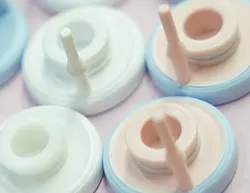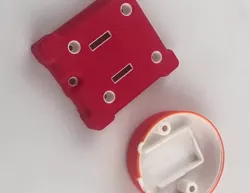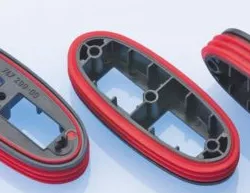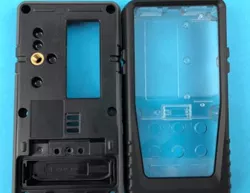What is Overmolding?
Overmolding is a two-shot plastic injection molding process that creates a single part by combining two different but complimentary thermoplastic materials.
The first shot, the substrate, is usually composed of more rigid plastic and is designed to accept the second shot, called the overmold. The overmold is typically composed of a softer, more flexible plastic-like rubber.
By mechanically or chemically bonding two plastic materials, the overmolding process can help product designers achieve additional functionality or aesthetics that would otherwise not be practical.




Why use the Overmolding process in plastic injection molding?
Tactical functionality
One of the more common reasons to use the overmolding process in injection molding is to create a soft grip.
From the example used above, the green part is used functionally as a twistable nozzle that will help direct the flow of a liquid. However, in this case, the plastic chosen to facilitate the flow and to keep its chemical resistance for lasting part integrity happens to be very rigid and stiff to the touch, not ideal for tightening and loosening with human hands.
The solution is to design an overmolded rubber-like grip to aid the user in twisting this product.
But, tactile functionality is not limited to human grip and can also be cleverly used to add rubber-like grips to clips designed to grab inanimate objects.
Here is another tactile example where a softer, rubber-like grip has been overmolded onto a rigid plastic part. In this case, the rubber-like grips are overmolded in two separate areas, which is the possible use of the overmolding process. It can be utilized in more than one area of the same part to achieve even more functionality.
Custom Overmolding With RJC
Need overmolded parts that are genuinely custom? You have come to the right place. RJC delivers high-quality, on-demand injection molding for prototypes and production parts.
Simply put, overmolding lets you combine multiple materials into one part. One material, usually a thermoplastic elastomer (TPE/TPV), is molded onto a second material, often a rigid plastic. Think about your toothbrush handle where the single piece has both rigid and rubbery components. It’s a great way to make plastic parts perform and look better. Please see our injection molding capabilities page for a complete list of our thermoplastic elastomer and rigid plastic material choices.
RJC takes a “have it your way” approach to all types of injection molding, no matter your level of experience. We specialize in complex projects, including those requiring side action or hand-loaded inserts. Our goal is to provide a long-term overmolding solution, moving beyond rapid prototyping, with dedicated project managers and engineering experts to communicate through all project stages from design to production. We offer molding solutions for every industry, including medical injection molding and US and China injection molding services.
RJCmold Overmolding Capabilities
RJCmold’s custom overmolding services ensure the creation of plastic parts that look and perform better. Our production line consists of an overmolding injection molding process that allows us to combine several different materials into one, ensuring you get superior-quality products.
| Standards | Metric Units | Imperial Units |
|---|---|---|
| Maximum Part Size | 200×400×100mm | 7.87×15.75×3.94in. |
| Minimum Part Size | 2×2×2mm | 0.08×0.08×0.08in. |
| Substrate Wall Thickness | From 0.5 to 3mm | From 0.20 to 0.12 in. |
| Tolerance | +/- 0.025 mm | +/- 0.00098 in. |
| Radii | 0.1mm | 0.0039in. |
| Depth | 100mm from the parting line | 3.94in. from the parting line |
| Mold Validation | Provide T0, T1, T2 samples before mass production | |
| Inspection and Certification Options | First Article Inspection, ISO 9001, ISO 13485 | |
| Lead Time | From mold making to sample delivery: 15-45 business days |
Materials Used For Overmolding
We offer a wide range of materials for overmolding projects, depending upon the geometry, complexity, and requirements of your project. These materials can be divided into three different categories, including:
|
Rigid Plastics |
Flexible Plastics |
Rubber Plastics |
|---|---|---|
| ABS | PE | TPE |
| Polypropylene | PS | TPU |
| Polycarbonate | PET | Silicon Rubber |
| Acrylic | EVA Foam | |
| Nylon | EPS Foam | |
| POM | PU Foam | |
| PTFE | ||
| PBT/PBT-PC | ||
| PEEK | ||
| HDPE | ||
| PVC | ||
| PPS | ||
| PI | ||
| PAI | ||
| UPE/UHMW | ||
| PVDF | ||
| ULTEM (PEI) |
Finishing
We offer multiple finishing options to complete the products made with the overmolding process. You can choose from any of the following depending upon your application’s requirements:
Overmolding Design Tips
Wall thicknesses between 0.060″ to 0.120″ (1.5 mm-3 mm) generally provide the best bonding.
Keeping radii between 0.020″ or 0.5mm minimum in corners reduces localized stresses.
If the part requires thick TPE sections, they should be cored out to minimize shrinkage problems, reduce the part weight, and lower cycle time.
Avoid deep or un-veritable blind pockets or ribs in your design.
Use gradual transitions between wall thickness to reduce or avoid problems with the flow (backfills, gas traps, etc.)
The TPE/TPV should be less thick than the substrate to prevent warpage, especially if the part is flat, long, or both.
Overmolding needs mechanical or chemical bonding to the substrate, so your material choices should enable this.
Applications of Overmolding
The injection overmolding process is compatible with a wide variety of materials, ranging from plastics to metals. This process helps produce custom prototypes and production parts for various applications depending on your requirements. Several industries find valuable uses for overmolding services.
Other Types of Injection Molding at RJC
Contact RJCmold for Custom Plastic Overmolding Services Today
RJCmold provides the end-to-end overmolding molding services you need to stay ahead of the game. Our team stable of state-of-the-art tooling and design capabilities combined with over 300,000 square feet of on-site production space allows us to create high quality molded parts designed to your project’s exact specifications . Read about our other plastic molding capabilities here. Request a quote today to begin discussing your overmolding requirements. Contact us with any questions.

